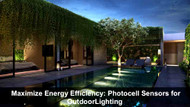Maximize Energy Efficiency: Photocell Sensors for Outdoor Lighting
Published by Light Bulb Surplus on Apr 24th 2023

Boost Energy Efficiency with Photocell Sensors: A Comprehensive Guide for Eco-Friendly Homes
Optimizing lighting systems is an effective way to minimize energy consumption and reduce electricity bills, contributing to a more eco-friendly home. One practical method for achieving this is through the installation and utilization of replacement photocells. In this comprehensive blog post, we will guide you through the process of understanding, selecting, installing, and adjusting photocell sensors to maximize energy efficiency and cost savings in your sustainable living space.
Grasping the Fundamentals of Photocell Sensors:
To successfully employ photocell sensors for energy conservation, it is crucial to grasp their basic operation principles. These light-sensitive devices use a photocell to measure natural light levels in indoor or outdoor environments. When ambient light dips below a predetermined threshold, the sensor triggers the lights to switch on. Conversely, when ambient light surpasses the threshold, the lights are switched off, saving energy and reducing your electricity bill.
Understanding Photocell Sensor Types for Outdoor Wall-Mounted and Ceiling Fixtures:
When selecting photocell sensors for outdoor lighting, it is essential to consider the differences between wall-mounted and ceiling fixtures to ensure you choose the most suitable sensor for each application.
Wall-mounted fixtures typically have a more direct exposure to sunlight, as they are installed on the exterior walls of your home. For these fixtures, you may need a photocell sensor with adjustable sensitivity settings, allowing you to fine-tune the sensor's responsiveness according to the amount of sunlight your fixture receives. This will help ensure that the lights turn on and off at appropriate times, maximizing energy efficiency.
On the other hand, outdoor ceiling fixtures are often installed under eaves, porches, or other covered areas, which may limit their direct exposure to sunlight. In these cases, you may require a photocell sensor with a higher sensitivity to compensate for the reduced light levels. Additionally, look for a sensor designed to function effectively in shaded environments, ensuring the lights still turn on and off based on the ambient light available.
Proper Photocell Sensor Installation for Energy Efficiency:
Before initiating the installation process, ensure the power to the circuit you will be working on is turned off. Follow the manufacturer's instructions meticulously to guarantee accurate installation. In general, the sensor needs to be wired into the circuit and mounted in a location where it can detect light levels effectively. After installation, test the sensor to ensure it is functioning correctly and fine-tune any settings as needed. A properly installed photocell sensor will contribute to increased energy efficiency in your lighting system.
Testing and Adjusting the Sensor for Optimal Performance:
After installing the photocell sensor, it is important to test and adjust it for optimal performance in your eco-friendly home. This may involve fine-tuning the sensitivity of the sensor to ensure it accurately detects light levels, as well as adjusting the timing of the sensor to guarantee it switches lights on and off at appropriate times. It may take some trial and error to achieve the perfect sensor settings, but with patience and persistence, you can enjoy the energy savings and efficiency benefits of a properly functioning photocell sensor.
Reap the Benefits of Energy Efficiency and Cost Savings:
Installing and using photocell sensors in your green home is an excellent way to enjoy the benefits of energy efficiency and cost savings. By automatically controlling lights based on the level of natural light available, photocell sensors contribute to a reduced electricity bill and a minimized carbon footprint. With straightforward installation and simple adjustments, you can start enjoying the advantages of photocell sensors in no time.
In conclusion, incorporating photocell sensors into your eco-friendly home can significantly improve energy efficiency and reduce electricity costs. By understanding the basics, choosing the right type, installing it correctly, and fine-tuning its performance, you can create a more sustainable living space and contribute to a greener planet.


